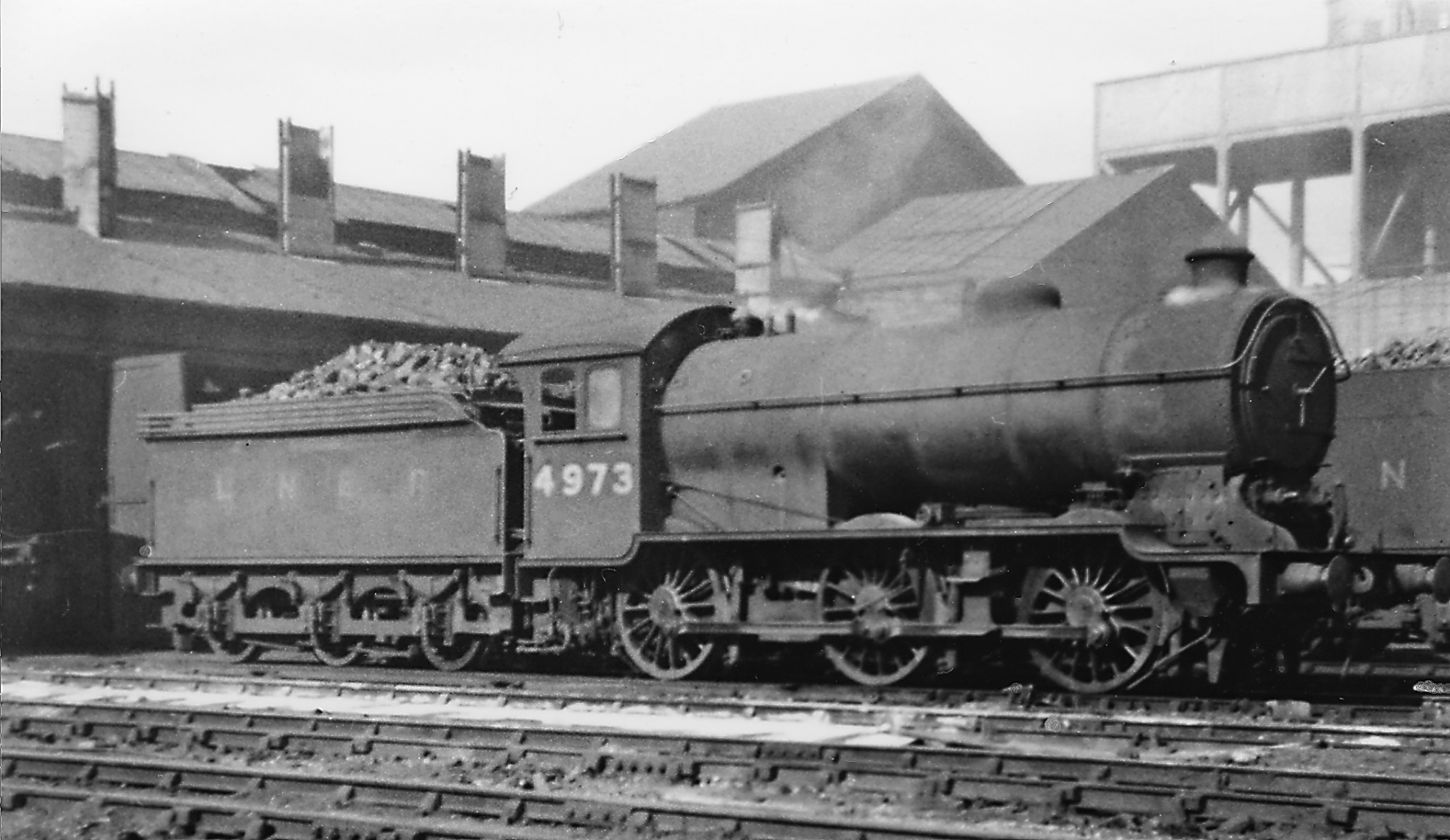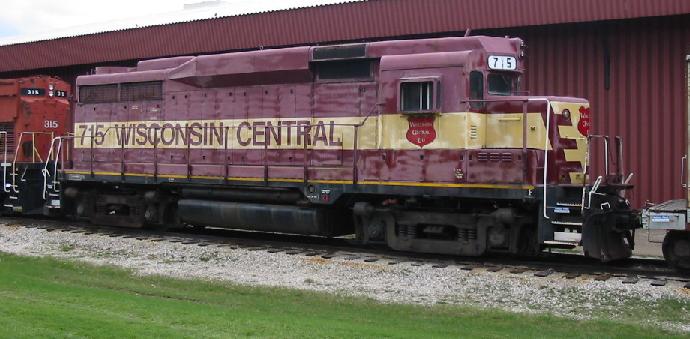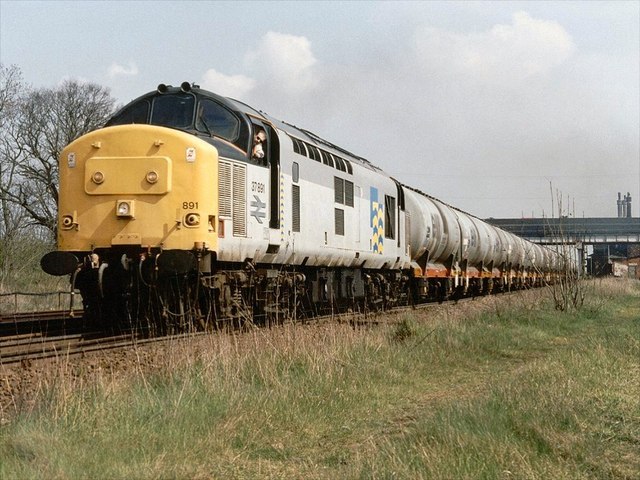|
Loadhaul
Loadhaul Ltd. was a railfreight operator based in the north-east of the United Kingdom. It was formed in 1994, as part of the privatisation of British Rail, and acquired in 1996 by a consortium headed by Wisconsin Central, then merged into a new company English Welsh & Scottish Railway. It is now part of DB Cargo. History Loadhaul was created in 1994, along with Transrail and Mainline as part of the broadly regional split of British Rail's Trainload Freight operations - Loadhaul's centre of operations were North East England, and South and East Yorkshire. The three companies were created with the aim of promoting competition between the businesses with the eventual aim of being privatised. It was initially and briefly named "Trainload Freight North East Limited" before being renamed Loadhaul Limited. All three former Trainload Freight companies including Loadhaul were acquired in February 1996 by 'North-South Railways': a company formed by a consortium led by US railroad com ... [...More Info...] [...Related Items...] OR: [Wikipedia] [Google] [Baidu] |
DB Cargo UK
DB Cargo UK (formerly DB Schenker Rail UK and English, Welsh & Scottish Railway (EWS)), is a British rail freight company headquartered in Doncaster, England. The company was established in early 1995 as ''North & South Railways'', successfully acquiring and merging five of the six freight companies that were sold during the privatisation of British Rail,The sixth rail freight company created during privatisation, Freightliner, was privatised through a management buyout. On 25 April 1996, the EWS brand was revealed and implemented over successive months. By the end of March 1997, it controlled 90% of the UK rail freight market, operated a fleet of 900 locomotives and 19,000 wagons, and had 7,000 employees. During the late 1990s, EWS invested heavily into rolling stock renewal, procuring a large number of British Rail Class 66 diesel locomotives, headcount was also reduced. It also acquired National Power's open-access freight operator in April 1998. During January 2001, the ... [...More Info...] [...Related Items...] OR: [Wikipedia] [Google] [Baidu] |
Mainline Freight
Mainline Freight was a trainload rail freight operator based in Islington, London, England with operations extending to Yorkshire in the north and Somerset in the west. It was formed from part of British Rail's Trainload Freight division as part of the privatisation of British Rail. Mainline Freight, Loadhaul and Transrail were purchased by a consortium led by Wisconsin Central in 1996 and amalgamated into a new company, English Welsh & Scottish. History Mainline Freight was created in 1994 along with Transrail and Loadhaul as part of the broadly regional split of British Rail's Trainload Freight operations - Mainline Freight's centre of operations were South East England, and East Anglia, and the East Midlands. Three companies were created with the aim of promoting competition between the businesses.Sources: * * It was initially and briefly named "Trainload Freight South East Limited" before being re-branded in September 1994. All three former Trainload Freight companie ... [...More Info...] [...Related Items...] OR: [Wikipedia] [Google] [Baidu] |
Immingham TMD
Immingham engine shed, also known as Immingham depot, or more recently as Immingham TMD and is a railway maintenance depot (traction maintenance depot) located on the Immingham Dock estate, in North East Lincolnshire, England. The depot code is ''IM''. In 2015 the depot was operated by DB Schenker. A separate TMD also known as Immingham TMD, but with the depot code ''IN'', is operated by Freightliner. History The engine shed was built by the Humber Commercial Dock and Railway company in the southeastern corner of the Immingham Dock estate. As initially built the engine shed had twelve "roads" (tracks) providing facilities for 60 locomotives. The railways at Immingham were worked by the Great Central Railway, the developer of the Port. In 1923 it was taken over by the LNER and then became part of the Eastern Region of British Railways in 1948. During the LNER period (1930s) a concrete automatic coaling stage was added to the facilities. During the British Railways peri ... [...More Info...] [...Related Items...] OR: [Wikipedia] [Google] [Baidu] |
Transrail Freight
Transrail was a trainload rail freight operator based in St Blazey, England, UK with a large operating area including Scotland, Wales and the west of England. It was formed in 1994 from part of British Rail's Trainload Freight division, as part of the privatisation of British Rail. Mainline Freight, Loadhaul and Transrail were purchased by a consortium led by Wisconsin Central in 1996 and amalgamated into a new company, English Welsh & Scottish. History Transrail was created in 1994 along with Mainline Freight and Loadhaul as part of the broadly regional split of British Rail's Trainload Freight operations. Transrail had the largest operating area of the three companies, operating in Scotland, Wales and the entire west of England (South West, West Midlands, and North West). The three companies were created with the aim of promoting competition between the businesses. It was initially and briefly named "Trainload Freight West Limited" before being re-branded in July 1994. T ... [...More Info...] [...Related Items...] OR: [Wikipedia] [Google] [Baidu] |
British Rail Class 56
The British Rail Class 56 is a type of diesel locomotive designed for heavy freight work. It is a Type 5 locomotive, with a Ruston-Paxman power unit developing 3,250 bhp (2,423 kW), and has a Co-Co wheel arrangement. Enthusiasts nicknamed them "Gridirons" (or "Grids" for short), due to the grid-like horn cover on the locomotive's cab ends fitted to nos. 56056 onwards. Under its Romanian railway factory nomenclature, the locomotive was named Electroputere LDE 3500, with LDE coming from ''Locomotivă Diesel-Electrică'' (Diesel-Electric Locomotive) and the 3500 being the planned horsepower output. The Class 56 fleet was introduced between 1976 and 1984, a total of 135 examples were manufactured. The first 30 locomotives (56001 - 56030, factory classification LDE3500) were built by Electroputere in Romania, but these typically suffered from poor construction standards and many were withdrawn from service early for extensive rebuilding before re-entering revenue service. The rem ... [...More Info...] [...Related Items...] OR: [Wikipedia] [Google] [Baidu] |
British Rail Class 37
The British Rail Class 37 is a diesel-electric locomotive. Also known as the English Electric Type 3, the class was ordered as part of the British Rail modernisation plan. They were numbered in two series, D6600–D6608 and D6700–D6999. The Class 37 became a familiar sight on many parts of the British Rail network, in particular forming the main motive power for InterCity services in East Anglia and within Scotland. They also performed well on secondary and inter-regional services for many years. Many are still in use today on freight, maintenance, and empty stock movement duties. The Class 37s are known to some railway enthusiasts as "tractors", a nickname given due to the similarities between the sound of the Class 37's engine and that of a tractor. Description Background As part of the large scale dieselisation brought about by the British Rail modernisation plan a need was identified for a number of type 3 locomotives of power output to . English Electric had alre ... [...More Info...] [...Related Items...] OR: [Wikipedia] [Google] [Baidu] |
Thornaby TMD
Thornaby TMD was a railway traction maintenance depot situated in Thornaby, England, latterly operated by DB Schenker. The depot was situated to the east of , on the northern side of the line to Middlesbrough. Background In the mid-1950s as part of British Railways modernisation plan, projects were developed to centralise the marshalling of goods wagons and the associated servicing of steam locomotives at the United Kingdoms largest freight hubs. Teesside had a number of marshalling yards servicing the coal mines and steel mills of Consett, West County Durham and North Yorkshire, as well as those for Middlesbrough Dock. The decision was hence taken to rationalise these to one yard, Tees Marshalling Yard on part of the site of the once electrified Erimus Marshalling Yard. Steam history Existing in the area were also four older steam sheds, which BR also planned to rationalise and close: *North of the River Tees: **Stockton (51E) **Haverton Hill (51G) near Port Clarence and ... [...More Info...] [...Related Items...] OR: [Wikipedia] [Google] [Baidu] |
Wisconsin Central Ltd
Wisconsin Central Ltd. is a railroad subsidiary of Canadian National. At one time, its parent Wisconsin Central Transportation Corporation owned or operated railroads in the United States, Canada (Algoma Central Railway), the United Kingdom ( English Welsh & Scottish), New Zealand (Tranz Rail), and Australia (Australian Transport Network). Overview Wisconsin Central Ltd. (WC) started in US in the mid-1980s using most of the original Wisconsin Central Railway's rights of way and some former Milwaukee Road rights of way after the Soo Line Railroad acquired the Wisconsin, Illinois, Indiana, Missouri and Minnesota holdings of the bankrupt Milwaukee Road and divested its older railway trackage in Wisconsin. In 1993 the Wisconsin Central also acquired the Green Bay and Western Railroad and the Fox River Valley Railroad. In 1995, Wisconsin Central acquired the Canadian Algoma Central Railway whose tracks ran north of Sault Saint Marie to Hearst, Ontario. The Algoma Central runs a p ... [...More Info...] [...Related Items...] OR: [Wikipedia] [Google] [Baidu] |
Trainload Freight
Trainload Freight was the sector of British Rail responsible for trainload freight services. The division was subdivided into four sub-sectors; coal, petroleum, metals and construction. It was formed in 1988 from the trainload operations of British Rail's Railfreight division. The company existed until 1994, when, as part of the privatisation process of British Rail, it was split into three separate companies by region: Load-Haul, Mainline Freight and Trans-Rail. History Trainload Freight (TLF) was created in 1988 as the sector of British Rail responsible for operating unit trains. The division was subdivided into four sub-sectors according to cargo carried: Coal, Construction, Metals, and Petroleum. Other wagonload freight activities and containerised freight were organised in the Railfreight Distribution (RfD) division at the same time. The trainload business represented approximately 80% of British Rail's total revenue from freight, and 90% of freight traffic by mass. Trai ... [...More Info...] [...Related Items...] OR: [Wikipedia] [Google] [Baidu] |
Privatisation Of British Rail
The privatisation of British Rail was the process by which ownership and operation of the railways of Great Britain passed from government control into private hands. Begun in 1994, it had been completed by 1997. The deregulation of the industry was initiated by EU Directive 91/440 in 1991, which aimed to create a more efficient rail network by creating greater competition. British Railways (BR) had been in state ownership since 1948, under the control of the British Railways Board (BRB). Under the Conservative government of Margaret Thatcher elected in 1979, various state-owned businesses were sold off, including various functions related to the railways – Sealink ferries and British Transport Hotels by 1984, Travellers Fare catering by 1988 and British Rail Engineering Limited (train building) by 1989. It was under Thatcher's successor John Major that the railways themselves were privatised, using the Railways Act 1993. The operations of the BRB were broken up and sold o ... [...More Info...] [...Related Items...] OR: [Wikipedia] [Google] [Baidu] |
British Rail
British Railways (BR), which from 1965 traded as British Rail, was a state-owned company that operated most of the overground rail transport in Great Britain from 1948 to 1997. It was formed from the nationalisation of the Big Four British railway companies, and was privatised in stages between 1994 and 1997. Originally a trading brand of the Railway Executive of the British Transport Commission, it became an independent statutory corporation in January 1963, when it was formally renamed the British Railways Board. The period of nationalisation saw sweeping changes in the railway. A process of dieselisation and electrification took place, and by 1968 steam locomotives had been entirely replaced by diesel and electric traction, except for the Vale of Rheidol Railway (a narrow-gauge tourist line). Passengers replaced freight as the main source of business, and one-third of the network was closed by the Beeching cuts of the 1960s in an effort to reduce rail subsidies. On privatis ... [...More Info...] [...Related Items...] OR: [Wikipedia] [Google] [Baidu] |
British Rail Class 60
The British Rail Class 60 is a class of Co-Co heavy freight diesel-electric locomotives built by Brush Traction. They are nicknamed ''Tugs'' by rail enthusiasts. During the 1980s, it became increasingly apparent that British Rail required a more capable Type 5 locomotive for its heavy freight trains. Dissatisfaction with the British Rail Class 56's reliability led to the stipulation of a 95 percent availability, a stringent requirement at the time. A total of three bids were received to a competitive tender issued on 10 August 1987; of these, Brush Traction's submission was selected and an order for 100 locomotives was issued during the following year. Despite the first example being completed during June 1989, due to a number of technical issues discovered during testing, the first examples of the Class 60 would not enter revenue service until late 1990. Operated only during the final years of British Rail, the entire Class 60 fleet became the property of English Welsh & Sco ... [...More Info...] [...Related Items...] OR: [Wikipedia] [Google] [Baidu] |








.jpg)
.jpg)